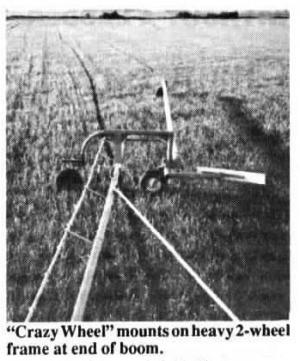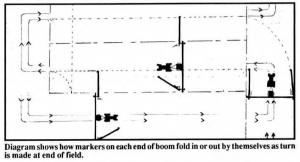1991 - Volume #15, Issue #1, Page #28
[ Sample Stories From This Issue | List of All Stories In This Issue | Print this story
| Read this issue]
Crazy Wheel Marker Keeps Sprayers In Line
 |
 |
"Even if you have a foam marker you have to guess where to drive the tractor by watching the end of the boom. I didn't like the skip marks and overlaps I got. If I calibrate the sprayer to apply 10 gal. per acre, that's what I want to apply," says Steinbach.
His marker consists of a "crazy" wheel, or castor, mounted on the end of a light-weight 4-in. dia. marker arm made out of aluminum irrigation pipe. A marker arm and wheel mounts on either end of the spray boom on a flexible hinge. Each arm is long enough to run from the end of the boom to the center point on the tractor.
Here's how the marker works. On each pass, one marker arm is folded in front of the spray boom and the other is in the extended position. When Vogt turns at the end of the field, the extended arm automatically folds in and the folded-in arm is extended. There are no hydraulics or electrical controls. The fold in, fold out action is activated by the turning of the tractor. Mechanical "stops" hold the boom in place when it's in either position.
When he starts spraying, Vogt first makes one pass around the perimeter of afield with the outside marker locked in. Then he starts his first pass over the field. As he gets to the end of the pass, he turns towards the side where the folded-out marker has left its tire track. As he turns, the hinge causes the marker to fold in against a stop while at the same time the turning action causes the folded-in marker to fold out. He aims the inside tractor wheel along the mark left by the marker wheel.
"You don't even have to think about it. There's an easy mark to follow with the tractor. I've totally eliminated skips and overlaps. It's fool-proof," says Vogt. He notes that the aluminum tubing works great for the marker because it's both light and strong.
"I built the marker during the winter of 1988-89 and used it last year with no problems. The only change I made after I built it was to add fluid to the crazy wheels for added weight to make the tire tracks more visible. The only cost was for two wheel-barrow wheels, 2 used sections of pipe, and some scrap metal for hinges," says Vogt.
Contact: FARM SHOW Followup, Ray Vogt, Box 1775, Steinbach, Manitoba, R0A 2A0 Canada (ph 204 326-9429).

Click here to download page story appeared in.

Click here to read entire issue
To read the rest of this story, download this issue below or click here to register with your account number.




